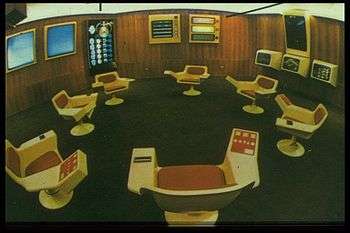Project Cybersyn

Project Cybersyn was a Chilean project from 1971–1973 during the presidency of Salvador Allende aimed at constructing a distributed decision support system to aid in the management of the national economy. The project consisted of four modules: an economic simulator, custom software to check factory performance, an operations room, and a national network of telex machines that were linked to one mainframe computer.[2]
Project Cybersyn was based on viable system model theory and a neural network approach to organizational design, and featured innovative technology for its time: it included a network of telex machines (Cybernet) in state-run enterprises that would transmit and receive information with the government in Santiago. Information from the field would be fed into statistical modeling software (Cyberstride) that would monitor production indicators (such as raw material supplies or high rates of worker absenteeism) in real time, and alert the workers in the first case, and in abnormal situations also the central government, if those parameters fell outside acceptable ranges. The information would also be input into economic simulation software (CHECO, for CHilean ECOnomic simulator) that the government could use to forecast the possible outcome of economic decisions. Finally, a sophisticated operations room (Opsroom) would provide a space where managers could see relevant economic data, formulate responses to emergencies, and transmit advice and directives to enterprises and factories in alarm situations by using the telex network.
The principal architect of the system was British operations research scientist Stafford Beer, and the system embodied his notions of organisational cybernetics in industrial management. One of its main objectives was to devolve decision-making power within industrial enterprises to their workforce in order to develop self-regulation of factories.
Name
The project's name in English (Cybersyn) is a portmanteau of the words "cybernetics" and "synergy". Since the name is not euphonic in Spanish, in that language the project was called Synco, both an initialism for the Spanish Sistema de INformación y COntrol, "system of information and control", and a pun on the Spanish cinco, the number five, alluding to the five levels of Beer's viable system model.
History
Stafford Beer was a British consultant in management cybernetics. He also sympathized with the stated ideals of Chilean socialism of maintaining Chile's democratic system and the autonomy of workers instead of imposing a Soviet-style system of top-down command and control.
In July 1971, Fernando Flores, a high-level employee of the Chilean Production Development Corporation (CORFO) contacted Beer for advice on incorporating Beer's theories into the management of the newly nationalized sector of Chile's economy. Beer saw this as a unique opportunity to implement his ideas on a national scale. More than offering advice, he left most of his other consulting business and devoted much time to what became Project Cybersyn. He traveled to Chile often to collaborate with local implementors and used his personal contacts to secure help from British technical experts.
The implementation schedule was very aggressive, and the system had reached an advanced prototype stage at the start of 1973.
The system was most useful in October 1972, when about 40,000 striking truck drivers blocked the access streets that converged towards Santiago. According to Gustavo Silva (executive secretary of energy in CORFO), using the system's telex machines, the government was able to guarantee the transport of food into the city with only about 200 trucks driven by strike-breakers, recouping the shortages caused by 40,000 striking truck drivers.[3]
After the military coup on September 11, 1973, Cybersyn was abandoned and the operations room was destroyed.
System
There were 500 unused telex machines bought by the previous government, each was put into one factory. In the control centre in Santiago, each day data coming from each factory (several numbers, such as raw material input, production output and number of absentees) were put into a computer, which made short-term predictions and necessary adjustments. There were four levels of control (firm, branch, sector, total), with algedonic feedback. If one level of control did not remedy a problem in a certain interval, the higher level was notified. The results were discussed in the operations room and a top-level plan was made.
The software for Cybersyn was called Cyberstride, and used Bayesian filtering and Bayesian control. It was written by Chilean engineers in consultation with a team of 12 British programmers.[4]
The futuristic operations room was designed by a team led by the interface designer Gui Bonsiepe. It was furnished with seven swivel chairs (considered the best for creativity) with buttons, which were designed to control several large screens that could project the data, and other panels with status information, although these were of limited functionality as they could only show pre-prepared graphs. This consisted of slides.[5]
The project is described in some detail in the second edition of Strafford Beer's books Brain of the Firm and Platform for Change. The latter book includes proposals for social innovations such as having representatives of diverse 'stakeholder' groups into the control centre.
Aesthetics
The Ops room used Tulip chairs similar to those used in the American science fiction TV programme Star Trek, although according to the designers, the style was not influenced by science fiction movies.[6]
References in popular culture
Chilean science fiction author Jorge Baradit published a Spanish-language science fiction novel Synco in 2008. It is an alternate history dystopia set in a 1979 where Allende's government was not overthrown and Chile became a technocratic totalitarian state in which the Cybersyn system was used to control all aspects of Chilean life.
See also
- ARPANET
- Chilean coup of 1973
- Economic calculation debate
- Enterprise resource planning
- Fernando Flores
- History of Chile
- Internet
- Material balance planning
- OGAS
- Planned economy
- Socialist economy
- Viable system model
References
- ↑ Cybersyn Chile - Opsroom
- ↑ "IU professor analyzes Chile's 'Project Cybersyn'". UI News Room. Retrieved 27 May 2013.
- ↑ Eden Medina (2006). "Designing Freedom, Regulating a Nation: Socialist Cybernetics in Allende's Chile". J. Lat. Amer. Stud. Cambridge University Press (38): 571–606. doi:10.1017/S0022216X06001179.
- ↑ Project Cybersyn | varnelis.net
- ↑ Medina, Eden. "Interview Eden Medina over Project Cybersyn". VPRO Tegenlicht. Retrieved 14 December 2015.
- ↑ Eden Medina (2011). Cybernetic Revolutionaries: Technology and Politics in Allende's Chile, 1st edn. Cambridge, Mass: MIT Press. ISBN 978-0-262-01649-0. section 4, p. 121.
External links
- Eden Medina, Cybernetic Revolutionaries: Technology and Politics in Allende's Chile, (Cambridge, Mass: MIT Press, 2011).
- Eden Medina, "Designing Freedom, Regulating a Nation: Socialist Cybernetics in Allende's Chile." Journal of Latin American Studies 38 (2006):571-606.(pdf)
- Lessons of Stafford Beer
- The CeberSyn heritage in the XXI Century
- The CyberSyn multimedia "reconstruction"
- Before ’73 Coup, Chile Tried to Find the Right Software for Socialism, by Alexei Barrionuevo. The New York Times. March 28, 2008
- The forgotten story of Chile's 'socialist internet'
- Futurism, fictional and science fictional - rambling and inspiring on BoingBoing
- Project Cybersyn | varnelis.net
- Rhizome.org: Project Cybersyn
- Stafford Beer, and Salvador Allende's Internet, and the Dystopian Novel
- Free As In Beer: Cybernetic Science Fictions
- Planning Machine at The New Yorker
- Allende’s socialist internet at Red Pepper
